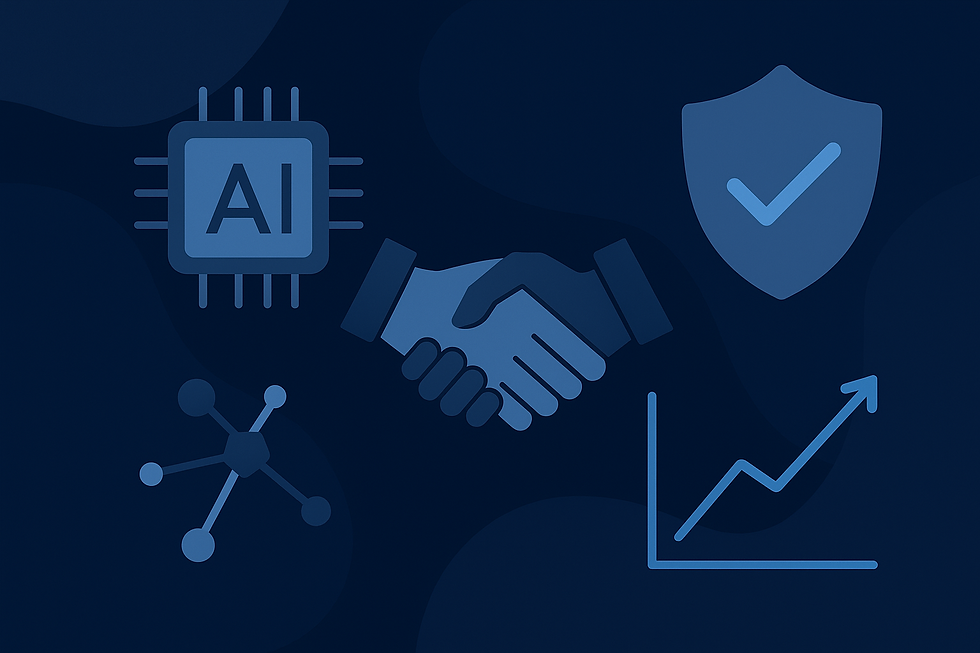AI and the Future of Work: Navigating the New Employment Landscape!
- jvourganas

- Mar 12, 2024
- 6 min read

Artificial Intelligence (AI) is increasingly recognised as a central agent of transformation in the global labour market, eliciting considerable analysis from academics, policy strategists, and industry leaders worldwide. This transformation is underscored by the acceleration of AI technologies, which hold the promise of redefining the landscape of employment through both the generation of novel employment opportunities and the obsolescence of traditional roles. The authors in [2] discuss how digital technologies, particularly AI, are at the heart of a significant shift towards an era marked by both challenges and opportunities in the job market, emphasizing the dual nature of technological advancement in creating new job domains while rendering others obsolete. A seminal study in [2] suggests that nearly 47% of employment in the United States is highly susceptible to automation, highlighting a pivotal shift in labour market dynamics influenced by AI and machine learning advancements. This revelation has sparked a broad discussion concerning the effects of AI and robotics on employment globally, with particular emphasis on how these trends may manifest differently in varied economic contexts such as the European Union (EU), China, and beyond.
The European Union presents a complex tableau of job automation risks, largely due to its diverse industrial landscape and uneven technology adoption rates among member states. A 2018 report by the European Commission indicates that 50% to 60% of jobs in the EU could face some degree of automation risk [3]. This variability is reflective of differing industrial emphases across the region; for example, manufacturing-centric economies like Germany and Poland might experience higher automation rates compared to those with a service-oriented focus, such as France or the Netherlands. The EU's commitment to worker rights and social safety mechanisms may also temper the speed and manner of automation adoption, potentially fostering initiatives aimed at workforce reskilling and adaptation.
Conversely, China's approach to automation and AI adoption is characterised by its ambitious pursuit to maintain a global manufacturing leadership. As reported in [5] up to 100 million jobs, or 12% of the Chinese workforce, might undergo automation within the next two decades. Yet, this substantial shift is anticipated to be counterbalanced by job creation in emerging sectors propelled by technological innovation, including healthcare, e-commerce, and green technologies. The Chinese government's vision to achieve global AI supremacy by 2030 further underscores a strategic commitment to integrating AI in ways that both augment and transform the national workforce [4].
One of the most salient domains in which Artificial Intelligence (AI) is anticipated to exert a significant influence is the enhancement of human productivity. In [6] researchers contend that the impact of AI and robotics extends beyond the mere automation of repetitive tasks; rather, it encompasses the amplification of human capabilities, thereby precipitating the creation of novel job categories. This process of augmentation is expected to catalyse an increased demand for competencies related to the management and oversight of AI systems, as well as the ethical considerations inherent in their deployment [7]. Consequently, the landscape of future employment is likely to evolve towards a paradigm characterized by more symbiotic interactions between humans and machines. Within this paradigm, AI is envisioned as a complement to human labour, enriching the potential for human achievement rather than serving as a direct replacement. This shift underscores a transformative potential in the workplace, where AI's role is to enhance and expand human capabilities, leading to a redefined ecosystem of work that values the unique contributions of both humans and machines.
Nevertheless, the phenomenon of job displacement engendered by AI-driven automation constitutes a formidable concern. A wide array of routine, manual, and cognitive tasks are succumbing to automation, precipitating employment contractions in several key sectors, including manufacturing, transportation, and administrative support [8]. This trend heralds significant challenges for individuals employed within these domains, underscoring the imperative for comprehensive reskilling and upskilling programs to ensure alignment with the dynamically transforming employment landscape [9]. In this evolving scenario, the responsibilities borne by educational institutions and policy architects are magnified, as they are entrusted with the pivotal role of equipping the workforce with the requisite skills and knowledge for the forthcoming job market [10]. The successful navigation of this transition demands a concerted effort to foster a resilient and adaptable labour force, capable of thriving amidst the complexities of an AI-infused economic paradigm.
The spatial allocation of employment opportunities is anticipated to undergo notable changes as a consequence of the integration of Artificial Intelligence (AI) into the economy. Insights from a study conducted by the McKinsey Global Institute [5] suggest that geographical regions characterized by a predominance of industries vulnerable to automation may encounter more pronounced displacement of jobs. In contrast, metropolitan areas that boast a heterogeneous array of economic sectors are poised to experience employment expansion, particularly in industries that harness AI for the purpose of innovation and the augmentation of services [11]. This variation in employment outcomes across different regions highlights the critical need for targeted economic planning and the strategic development of technological infrastructure at the regional level. Such measures are imperative to buffer the potential negative impacts of AI on the labour market, ensuring a balanced and equitable transition towards a future where AI plays a central role in shaping economic landscapes.
The ethical ramifications of Artificial Intelligence (AI) integration within the employment sector demand meticulous scrutiny. Concerns related to data privacy, increased surveillance capabilities, and the perpetuation of the digital divide present substantial risks of deepening the existing disparities within the labour market [12]. As such, the trajectory of AI technology development and its application across various industries necessitates a governance approach grounded in ethical principles. These frameworks must champion the cause of human well-being, ensuring that the benefits of AI are equitably distributed and that access to future employment opportunities is not hindered by technological advancements. Moreover, it is imperative that these ethical guidelines address the potential for AI to unintentionally entrench or amplify societal inequalities, advocating for interventions that promote inclusivity and fairness in the evolving digital economy [13]. This holistic ethical perspective is essential for steering the advancement of AI technologies towards outcomes that reinforce social equity and the universal right to meaningful employment.
In summary, the landscape of employment in the age of Artificial Intelligence (AI) is marked by a dualistic nature, comprising both formidable challenges and unprecedented opportunities. The encroachment of automation into the realm of routine tasks harbors the potential for significant job displacement, a development that raises concerns about the future of labor. Concurrently, AI harbors the capacity for engendering job creation, augmenting productivity levels, and catalyzing the emergence of novel industry sectors. The crucible for successfully navigating this complex transition is found within the adaptive recalibration of educational systems, the establishment of robust and forward-thinking policy frameworks, and the rigorous application of ethical standards that prioritize the equitable distribution of AI's benefits throughout the societal fabric.
The intricate relationship between AI and employment is underpinned by a dynamic that is continually evolving, underscoring the imperative for sustained research endeavors and an ongoing dialogue among stakeholders. This process is essential for delineating strategies that align technological advancement with the enrichment of human labor, ensuring that the forward march of AI technology harmonizes with the aspirations, needs, and welfare of humanity. Such an approach promises to shape a future where technological innovation and human endeavor interlace seamlessly, fostering an environment where the symbiosis between AI and the workforce not only mitigates the challenges of transition but also amplifies the collective potential for growth and development.
References.
1. Frey, C.B., & Osborne, M.A. (2017). The future of employment: How susceptible are jobs to computerisation? Technological Forecasting and Social Change, 114, 254-280.
2. Brynjolfsson, E., & McAfee, A. (2014). The second machine age: Work, progress, and prosperity in a time of brilliant technologies. W.W. Norton & Company.
3. European Commission. (2018). The 2018 Reform of EU Data Protection Rules.
4. Lee, K.-F. (2018). AI Superpowers: China, Silicon Valley, and the New World Order. Houghton Mifflin Harcourt.
5. McKinsey Global Institute. (2017). A future that works: Automation, employment, and productivity.
6. Bughin, J., et al. (2018). Notes from the AI frontier: Applications and value of deep learning. McKinsey Global Institute.
7. Davenport, T.H., & Ronanki, R. (2018). Artificial Intelligence for the Real World. Harvard Business Review.
8. Acemoglu, D., & Restrepo, P. (2020). Robots and jobs: Evidence from US labor markets. Journal of Political Economy, 128(6), 2188-2244.
9. Autor, D. (2015). Why are there still so many jobs? The history and future of workplace automation. Journal of Economic Perspectives, 29(3), 3-30.
10. Schwab, K. (2017). The Fourth Industrial Revolution. Crown Publishing Group.
11. Manyika, J., et al. (2017). A future that works: Automation, employment, and productivity. McKinsey Global Institute.
12. Crawford K. Artificial intelligence’s white guy problem. The New York Times. 2016 Jun 25;25(06):5.
13. Gordon F. Virginia Eubanks (2018) Automating Inequality: How High-Tech Tools Profile, Police, and Punish the Poor. New York: Picador, St Martin’s Press. Law, Technology and Humans. 2019 Nov 25:162-4.




Comments